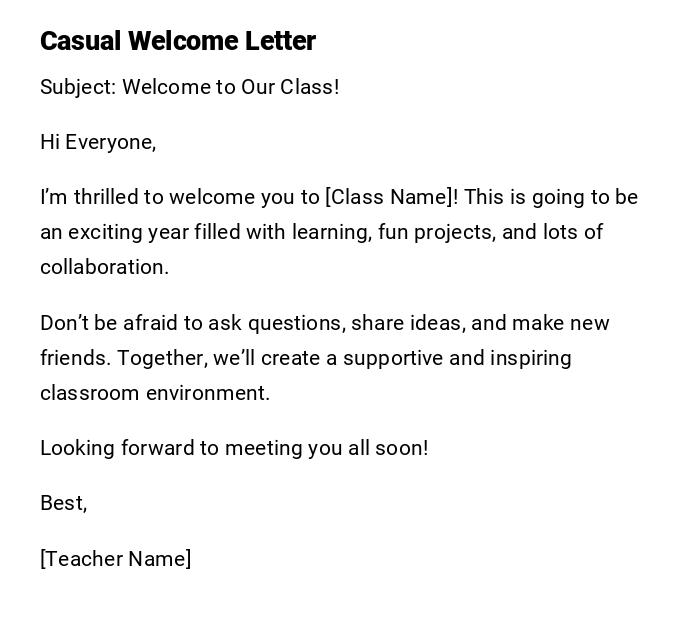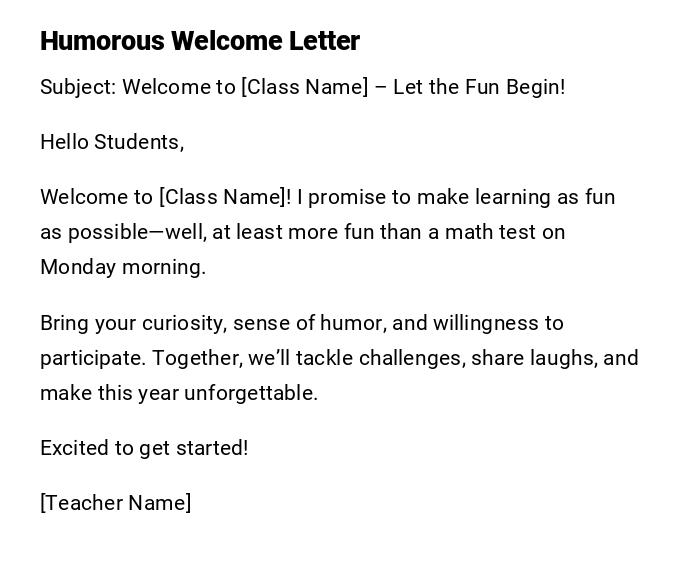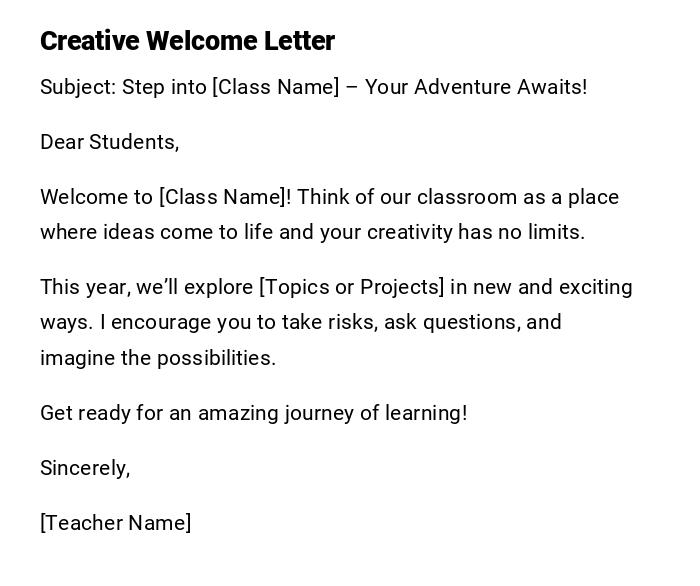Classroom Welcome Letter
[Your School Name]
[Address]
[City, State, Zip Code]
[Date]
Dear Students and Parents/Guardians,
Welcome to [Your Classroom Name]!
I am delighted to extend a warm welcome to all of you as we embark on an exciting learning journey together this academic year. My name is [Your Name], and I am thrilled to be your child's teacher for this school year. I am committed to providing a positive, nurturing, and enriching educational experience for each and every student in our classroom.
As we begin this new school year, I would like to take this opportunity to share a little bit about myself and my teaching philosophy. I hold a deep passion for education and believe that every child has unique strengths and abilities waiting to be nurtured. My goal is to create a safe and inclusive learning environment where all students feel valued, respected, and encouraged to explore their full potential.
Throughout the year, we will cover various subjects and engage in exciting projects that will spark curiosity and creativity. I will strive to make learning enjoyable, relevant, and applicable to real-life situations. Collaboration, critical thinking, and effective communication will be integral parts of our classroom activities, fostering essential skills that will benefit your child beyond the classroom.
Open communication and strong partnerships with parents/guardians are crucial to a successful academic year. I encourage you to reach out to me with any questions, concerns, or insights you may have about your child's progress or well-being. Together, we can create a supportive network to ensure your child's success.
Communication will primarily occur through [preferred communication channels, e.g., email, phone, ClassDojo, etc.]. Additionally, I will be sending regular updates on the classroom activities, assignments, and any upcoming events. Please make sure to check your child's backpack for important notices and information.
To ensure a smooth start to the school year, I request that students come prepared with the necessary school supplies listed below:
[List of required school supplies]
If, for any reason, you are unable to provide any of these supplies, please don't hesitate to let me know, and we will make arrangements to ensure your child has what they need to succeed.
Finally, I encourage you to attend our upcoming Back-to-School Night, where we can get to know each other better and discuss further details about the upcoming academic year. Details about the event will be shared soon.
I am looking forward to meeting all of you and working together to create an enriching and fulfilling learning experience. Let's make this a fantastic school year!
Thank you for your support and cooperation.
Sincerely,
[Your Name]
[Your Classroom Name]
[Grade Level] Teacher
Formal Classroom Welcome Letter
Subject: Welcome to [Class Name]
Dear Students,
Welcome to [Class Name] for the [School Year/Term]! I am delighted to have each of you in this class and look forward to a productive and enjoyable learning experience together.
This year, we will explore [Brief Description of Topics or Curriculum]. Please come prepared, participate actively, and engage with your classmates to make the most of this learning journey.
I am excited to see your growth and achievements throughout the term. Let’s make it a memorable and successful year.
Sincerely,
[Teacher Name]
Casual and Friendly Classroom Welcome Letter
Subject: Welcome to Our Class!
Hi Everyone,
I’m thrilled to welcome you to [Class Name]! This is going to be an exciting year filled with learning, fun projects, and lots of collaboration.
Don’t be afraid to ask questions, share ideas, and make new friends. Together, we’ll create a supportive and inspiring classroom environment.
Looking forward to meeting you all soon!
Best,
[Teacher Name]
Heartfelt Classroom Welcome Letter
Subject: A Warm Welcome to [Class Name]
Dear Students,
I am genuinely excited to welcome each of you to [Class Name]! Every one of you brings unique talents and perspectives, and I can’t wait to see how we will grow together this year.
Our classroom is a place for curiosity, creativity, and mutual respect. Let’s work together to make it a safe and inspiring environment for everyone.
Here’s to a wonderful year of learning and growth!
Warm regards,
[Teacher Name]
Funny Classroom Welcome Letter
Subject: Welcome to [Class Name] – Let the Fun Begin!
Hello Students,
Welcome to [Class Name]! I promise to make learning as fun as possible—well, at least more fun than a math test on Monday morning.
Bring your curiosity, sense of humor, and willingness to participate. Together, we’ll tackle challenges, share laughs, and make this year unforgettable.
Excited to get started!
[Teacher Name]
Creative Classroom Welcome Letter
Subject: Step into [Class Name] – Your Adventure Awaits!
Dear Students,
Welcome to [Class Name]! Think of our classroom as a place where ideas come to life and your creativity has no limits.
This year, we’ll explore [Topics or Projects] in new and exciting ways. I encourage you to take risks, ask questions, and imagine the possibilities.
Get ready for an amazing journey of learning!
Sincerely,
[Teacher Name]
Quick and Simple Classroom Welcome Letter
Subject: Welcome!
Hi Students,
Welcome to [Class Name]! I am looking forward to a fun and productive year together.
Let’s learn, grow, and make the most of this class.
[Teacher Name]
Professional Classroom Welcome Letter
Subject: Welcome to [Class Name]
Dear Students,
It is my pleasure to welcome you to [Class Name]. This year, we will focus on achieving excellence in [Subject/Topics].
I expect active participation, punctuality, and dedication from each student. Together, we will create a positive and productive learning environment.
Looking forward to a successful term,
[Teacher Name]
Informal Email Classroom Welcome
Subject: Hello and Welcome to [Class Name]!
Hi Everyone,
Welcome to [Class Name]! I’m excited to meet all of you and kick off a fantastic year.
Feel free to reach out with any questions before our first class. Let’s make this year both fun and educational!
Cheers,
[Teacher Name]
What is a Classroom Welcome Letter and Why You Need One
- A classroom welcome letter is a written message from a teacher to students at the start of a new term or school year.
- It sets the tone for the class, communicates expectations, and creates a sense of belonging.
- Helps students feel acknowledged, motivated, and prepared for the learning journey ahead.
Who Should Send a Classroom Welcome Letter
- Classroom teachers or instructors responsible for student learning.
- Homeroom teachers for younger grades.
- School administrators in some cases to introduce specialized programs or classes.
Whom the Classroom Welcome Letter is Addressed To
- Students enrolled in the specific class or course.
- Parents or guardians, especially for younger students or special programs.
- Occasionally, school staff or teaching assistants may also be included.
When to Send a Classroom Welcome Letter
- At the start of a new school year or term.
- When students are newly admitted to the class mid-term.
- Before virtual classes start to establish initial engagement.
How to Write and Send a Classroom Welcome Letter
- Choose the tone: formal, casual, or creative depending on class and audience.
- Include a warm greeting, introduction, and brief overview of the curriculum or topics.
- Set expectations and encourage engagement.
- Close with a motivational or welcoming note.
- Deliver via email for digital classes, printed letter for physical classrooms, or both.
Requirements and Prerequisites for a Classroom Welcome Letter
- Confirm the list of enrolled students.
- Gather information about the class schedule, topics, and activities.
- Clarify any school policies or rules to be mentioned.
- Ensure the tone matches the age group and formality of the classroom.
Formatting and Style Guidelines for Classroom Welcome Letters
- Length: 150–300 words for readability.
- Tone: Can vary between formal, casual, or creative.
- Structure: Greeting, introduction, class overview, expectations, closing.
- Use clear, friendly language suitable for students’ age.
- Include teacher’s contact info or office hours for questions.
Common Mistakes in Classroom Welcome Letters
- Using overly long or complex language that is hard to read.
- Failing to introduce the teacher or class objectives clearly.
- Omitting instructions or important details about the first class.
- Being too informal or too serious for the audience.
- Sending the letter too late for students to prepare.
Pros and Cons of Sending a Classroom Welcome Letter
Pros:
- Builds rapport and trust with students early on.
- Provides essential information and expectations.
- Encourages engagement and preparation for class.
Cons:
- Requires extra time and effort from teachers.
- May be overlooked by students if too lengthy or uninteresting.
Tips and Best Practices for Classroom Welcome Letters
- Keep it concise and friendly.
- Personalize if possible by mentioning students or class goals.
- Include motivating or encouraging language.
- Use bullet points for important instructions or topics.
- Send the letter before the first class to maximize impact.
Elements and Structure of a Classroom Welcome Letter
- Subject Line: Clear and inviting.
- Greeting: Address students warmly.
- Introduction: Teacher introduction and background.
- Class Overview: Topics, projects, and learning goals.
- Expectations: Rules, participation, and responsibilities.
- Closing: Encouragement, motivational note, and contact information.
- Optional Attachments: Schedule, syllabus, or reading list.
After Sending a Classroom Welcome Letter
- Confirm that all students received the letter, especially for email distribution.
- Address any questions or concerns that students or parents might have.
- Use the letter as a reference point during the first class for introductions and expectations.
FAQ About Classroom Welcome Letters
- Q: Should parents receive the letter too?
A: For younger students or special programs, including parents is recommended. - Q: How long should the letter be?
A: Keep it concise—usually under 300 words. - Q: Can humor be included?
A: Yes, if appropriate for the age group and class atmosphere. - Q: Is it okay to send digitally?
A: Yes, email is often preferred for speed and accessibility.
Compare and Contrast Classroom Welcome Letters with Other Methods
- Letter vs. Verbal Welcome: Written letters provide information in advance; verbal welcomes are immediate but less permanent.
- Letter vs. Email Announcement: Email is faster and eco-friendly; printed letters may feel more personal for younger students.
- Letter vs. Orientation Presentation: Letters serve as a reference; presentations engage visually but may lack detailed instructions.










 Download Word Doc
Download Word Doc
 Download PDF
Download PDF